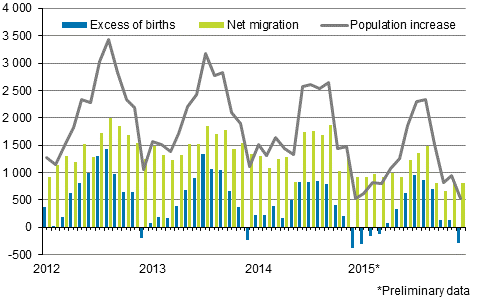Published: 26 January 2016
Record low number of children were born in Finland in 2015
According to Statistics Finland's preliminary data, 55,040 children were born in Finland in 2015. Fewer children were last born during the Great Famine in the 1860s. Despite the fall in the number of births, the country's population grew by 14,860 persons during 2015. The main reason for the population increase was migration gain from abroad: the number of immigrants was 11,900 higher than that of emigrants. Asylum seekers whose application process for asylum is not complete are not included in this figure. Natural population increase, or excess of births to deaths, was only 2,960 persons. The preliminary population figure at the end of 2015 was 5,486,616.
Population increase by month 2012–2015*

During 2015, Finland's population increased by 6,200 fewer persons than one year previously. The biggest reason for the contraction in population increase was the fallen migration gain received from abroad. Migration gain for immigration was 4,120 lower than the year before. Natural population increase went down by 2,080 persons from one year earlier.
According to the preliminary statistics for 2015, altogether 26,260 persons immigrated to Finland from abroad and 14,460 persons emigrated from Finland. The number of immigrants was 5,140 lower and the number of emigrants 1,020 lower than in the previous year. 7,130 of the immigrants and 9,890 of the emigrants were Finnish citizens.
During 2015, a total of 55,040 children were born, which is 2,190 fewer than in 2014. The number of deaths was 52,080, which is 110 lower than one year earlier.
According to the preliminary data, the number of inter-municipal migrations totalled 274,510 by the end of December. Compared with the previous year, the increase was 5,600 migrations according to the municipal division of 2015. The number of migration inside region increased 3,530 and the number of migration between regions 2,070 from one year earlier.
According to preliminary data by region, the population grew in the following regions in 2015: Uusimaa, Pirkanmaa, North Ostrobothnia, Varsinais-Suomi, Ostrobothnia, Central Finland, Central Ostrobothnia, and Åland.
In 2015, the population grew most in absolute numbers in Uusimaa, where it grew by 16,780 persons. The next largest increase in population was seen in Pirkanmaa, 2,720 persons. Relative to the population, population increase was highest in Uusimaa, 10.4 per mil and in Pirkanmaa, 5.4 per mil. Relative population growth was third largest in North Ostrobothnia, 3.9 per mil. Population loss was highest in absolute numbers in the region of Etelä-Savo that lost 1,270 persons of its population. The population of Kymenlaakso decreased by 1,180 persons, which was the second most. Relative to the population, the biggest population loss was found in Kainuu, 11.1 per mil and the second biggest in Etelä-Savo, 8.4 per mil.
Most migration gain from intramunicipal and international migration was collected by Uusimaa, 10,930 persons and Pirkanmaa, 2,190 persons. Most migration gain in relative terms was attained by Uusimaa, 6.8 per mil and by Pirkanmaa, 4.3 per mil.
In absolute numbers, migration loss from total net migration was biggest in the region of South Ostrobothnia, 660 persons. In the region of Lapland the loss was 520 persons. In relative terms, the biggest migration loss from total net migration was found in the region of Kainuu, 5.7 per mil of the population.
During 2015, migration between regions numbered 129,170. The highest gain from migration between regions was seen in Uusimaa, Pirkanmaa, Varsinais-Suomi, Central Finland, Åland and Pohjois-Savo. In absolute numbers, the highest gain from migration between regions was received by Uusimaa, 5,790 persons, and Pirkanmaa, 1,350 persons. Relative to the population, population increase was highest in Uusimaa, 3.6 per mil and in Pirkanmaa, 2.7 per mil.
Migration loss from migration between regions was biggest in the region of North Ostrobothnia, 990 persons. In relative terms, migration loss from migration between regions was biggest in the region of Kainuu, 7.8 per mil of the population.
Source: Population and Justice Statistics. Statistics Finland
Inquiries: Eevi Lappalainen 029 551 3367, Matti Saari 029 551 3401, info@stat.fi
Director in charge: Jari Tarkoma
Publication in pdf-format (292.9 kB)
- Tables
-
Tables in databases
Pick the data you need into tables, view the data as graphs, or download the data for your use.
Appendix tables
- Appendix table 1. Preliminary data on vital statistics by month of occurence 2015 (26.1.2016)
- Appendix table 2. Vital statistics, final data 2005-2014 and preliminary data 2015* (26.1.2016)
- Appendix table 3. Comparison between preliminary vital statistics in 2015 and 2014 (26.1.2016)
- Appendix table 4. Preliminary vital statistics by region 2015 and change compared to 2014 final data, quarters 1 - 4 (26.1.2016)
- Appendix table 5. Preliminary data by region on immigrants and emigrants according to country of departure/destination 2015, quarters 1 - 4 (26.1.2016)
- Figures
-
- Appendix figure 1. Live births by quarter 1994 - 2014 and preliminary data 2015 (26.1.2016)
- Appendix figure 2. Deaths by quarter 1994 - 2014 and preliminary data 2015 (26.1.2016)
- Appendix figure 3. Intermunicipal migration by quarter 1994 - 2014 and preliminary data 2015 (26.1.2016)
- Appendix figure 4. Immigration by quarter 1994 - 2014 and preliminary data 2015 (26.1.2016)
- Appendix figure 5. Emigration by quarter 1994 - 2014 and preliminary data 2015 (26.1.2016)
Updated 26.1.2016
Official Statistics of Finland (OSF):
Preliminary population statistics [e-publication].
ISSN=2243-3627. December 2015. Helsinki: Statistics Finland [referred: 15.12.2025].
Access method: http://stat.fi/til/vamuu/2015/12/vamuu_2015_12_2016-01-26_tie_001_en.html

